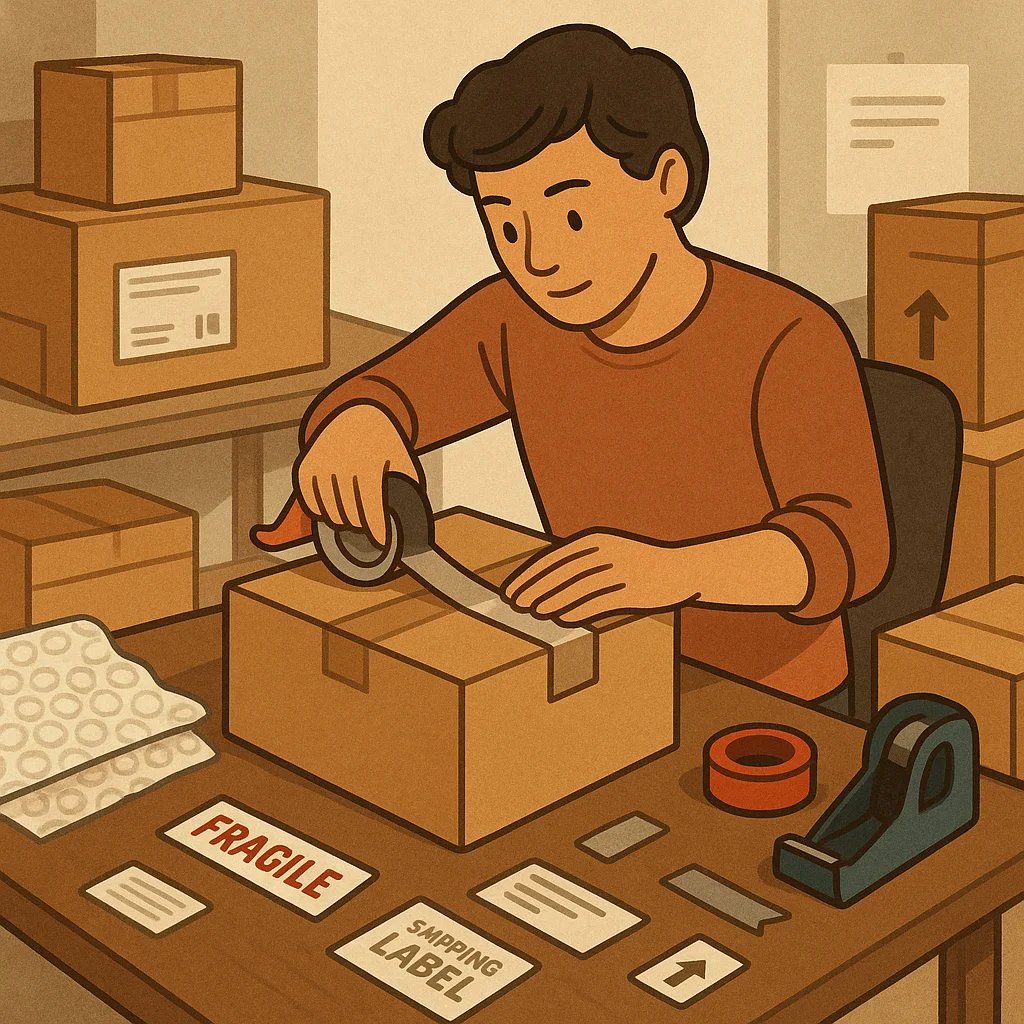Comprehensive Guide to Shipping Boxes
Key Takeaway: Properly shipping a box involves selecting the right packaging materials, following systematic packing steps, correctly labeling and documenting the shipment, and choosing an appropriate carrier. Attention to detail at each stage ensures your package arrives safely, on time, and cost-effectively.
1. Introduction
Shipping boxes is a fundamental aspect of both personal and business logistics. Whether sending a gift, returning an online purchase, or fulfilling customer orders, understanding how to pack and ship boxes correctly is crucial. Errors can result in damaged goods, delayed delivery, unexpected costs, or regulatory issues. This guide covers every step-from selecting the right box and cushioning materials to choosing carriers, completing customs documentation, and best practices for domestic and international shipments. By following these recommendations, you’ll minimize risks and ensure a smooth shipping experience.
2. Selecting the Right Box
Box Types and Sizes
Choosing a suitable box is the first critical decision. Boxes come in various styles:
- Regular Slotted Container (RSC): The most common, with flaps meeting at the center.
- Half-Slotted Container (HSC): One side open, ideal for slide-in products.
- Full Telescope Container (FTC): Two-piece lid and base, offering extra height adjustment.
- Die-Cut and Specialty Boxes: Custom shapes for unique items.
Box sizes should accommodate your items plus cushioning. Measure length, width, and height of the product(s), then add at least 5 cm (2 in) on all sides for padding.
Material Strength
Boxes are rated by their Edge Crush Test (ECT) or Bursting Test (Mullen):
- An ECT rating of 32 or higher is standard for shipping most items.
- For heavier or fragile goods, consider double-wall or triple-wall cardboard with higher ECT values (44+).
3. Essential Packaging Materials
Successful shipping hinges on high-quality packing supplies:
- Cushioning Materials
- Bubble Wrap: Offers excellent protection for fragile items.
- Foam Peanuts: Good for filling voids but can shift; use packing paper as an additional buffer.
- Air Pillows: Lightweight void-fill that resists moisture.
- Sealing Tape
- Water-Activated (Gummed) Tape: Bonds strongly to corrugated fibers; ideal for heavy loads.
- Pressure-Sensitive (Filament) Tape: Reinforced with fiberglass; high tensile strength.
- Labels and Marking Tools
- Shipping Labels: Pre-printed with barcodes and addresses for carriers.
- Fragile/Orientation Labels: “Fragile,” “This Side Up,” or “Handle with Care” stickers to communicate handling instructions.
- Protective Inserts
- Corner Protectors: Cardboard or foam supports to reinforce box corners.
- Dividers: Cardboard inserts separating multiple items (common for glassware or bottles).
4. Step-by-Step Packing Process
4.1 Pre-Packing Preparation
- Clean your work area to avoid dirt or debris inside the box.
- Gather all materials within reach to streamline the process.
- Inspect the box for damage-dented or wet boxes compromise integrity.
4.2 Cushioning the Base
Line the bottom of the box with 2–3 cm (1 in) of cushioning. For heavy items, use a dense layer of corrugated cardboard sheets or foam.
4.3 Wrapping Individual Items
- Wrap each item individually using bubble wrap or foam sheeting.
- Secure the wrap with tape to prevent unwrapping during transit.
- For irregular shapes, wrap snugly and use void-fill to immobilize.
4.4 Placing Items and Filling Voids
- Place heavier items on the bottom and lighter ones on top to maintain stability.
- After positioning, fill all gaps with additional packing peanuts, crumpled paper, or air pillows.
- Verify that items do not shift when the box is gently shaken.
4.5 Layer Protection
For multi-tiered contents, add a divider board or extra layer of cushioning between levels. This prevents items from crushing each other.
4.6 Sealing the Box
Use the H-taping method:
- Seal the center seam of the box with a strip of tape.
- Apply two strips along the edges where the flaps meet the side walls.
- Repeat on the bottom if not already sealed.
Seal all seams thoroughly, ensuring no gaps exist. For heavy shipments, apply a second layer of tape for reinforcement.
5. Labeling and Documentation
5.1 Address Label
- Print or write the recipient’s full name, street address, city, state/province, postal code, and country.
- Include the sender’s return address on the top-left or back of the box.
5.2 Barcodes and Tracking
- Many carriers require a scannable barcode. Use the carrier’s online platform or in-branch service to generate and print labels.
- Position the barcode on a flat surface of the box, away from seams or edges.
5.3 Handling Instructions
- Affix “Fragile,” “This Side Up,” or “Perishable” labels as applicable.
- Orient these labels so they are easily visible to handlers.
5.4 Customs Documentation for International Shipments
- Commercial Invoice: Describes contents, value, and harmonized system (HS) codes.
- Packing List: Itemizes each product inside the package.
- Certificates of Origin or Export Licenses: Required for certain restricted goods.
- Electronic Data Interface (EDI) Filings: Some carriers offer automated customs clearance.
Failure to include accurate customs documents can result in delays, fines, or seizure of goods.
6. Choosing a Shipping Carrier
Selecting the right carrier depends on cost, speed, reliability, and destination:
- National Postal Services (USPS, Canada Post, Royal Mail)
- Generally the most cost-effective for small packages.
- Slower ground services; priority or express options available.
- Courier Companies (FedEx, UPS, DHL)
- Expedited and guaranteed delivery windows.
- Comprehensive tracking and customer support.
- Higher cost, especially for international shipping.
- Freight Forwarders
- Best for oversized, palletized, or bulk shipments.
- Offer sea freight, air freight, and intermodal transport.
- Require palletizing and may involve consolidation centers.
- Third-Party Logistics (3PL) Providers
- Ideal for businesses outsourcing warehousing and fulfillment.
- Provide integrated inventory management and shipping solutions.
Cost Considerations
- Compare rates based on weight, dimensions, delivery speed, and insurance.
- Utilize carrier rate calculators or third-party shipping aggregators to find optimal pricing.
7. Shipping Scenarios
7.1 Domestic Shipping
- Typically simpler customs procedures (if any).
- Options include ground, air, and priority mail.
- Transit times range from overnight to 5+ days.
7.2 International Shipping
- May require harmonized tariffs and duties paid by sender or recipient.
- Transit times vary widely (air: 1–7 business days; sea: 4–8 weeks).
- Restricted items lists vary by country-check carrier and government regulations.
7.3 Hazardous Materials
- Flammable liquids, batteries, chemicals require special packaging and labeling under IATA, IMDG, or ADR regulations.
- Only certified shippers should handle these; documentation is stringent.
8. Tracking, Insurance, and Claims
8.1 Tracking
- Use the carrier’s online tracking portal with the provided tracking number.
- Set up email or SMS notifications for real-time status updates.
8.2 Insurance
- Carrier liability is often limited (e.g., $100 for USPS).
- Purchase additional insurance for high-value items-carrier or third-party insurers can provide cover up to declared value.
8.3 Filing Claims
- Document the condition of package and contents upon shipping.
- For damaged or lost shipments, file a claim promptly with photos, receipts, and records of value.
9. Cost-Saving Tips
- Consolidate Shipments: Combine smaller boxes into one larger box when feasible.
- Use Flat-Rate Services: Some carriers offer flat-rate boxes where weight is irrelevant up to a size limit.
- Negotiate Volume Discounts: Businesses shipping regularly can often secure lower rates.
- Optimize Box Size: Avoid excessive void-fill; smaller boxes reduce dimensional weight fees.
- Pre-Purchase Postage: Online postage often comes at discounted rates.
10. Sustainability and Eco-Friendly Practices
- Choose boxes made from recycled content and that are fully recyclable.
- Use biodegradable packing peanuts or recycled paper instead of plastic-based fillers.
- Encourage returnable packaging for frequent shipments between fixed locations.
- Partner with carriers offering carbon-neutral options or invest in carbon offsets.
11. Common Mistakes to Avoid
- Underpacking: Leads to damage; always provide sufficient cushioning.
- Overpacking: Increases shipping costs and may cause box bursting.
- Incorrect Dimensions: Carrier fees are based on both weight and size-measure accurately.
- Illegible Labels: Smudged or poorly printed addresses can delay delivery.
- Ignoring Restrictions: Certain items (lithium batteries, aerosols) need special handling.
12. Conclusion
Shipping a box-from gathering materials and packing securely to labeling accurately and choosing the right carrier-requires a methodical approach. By following this comprehensive guide, shippers can ensure that their packages arrive safely, on time, and with minimal cost or regulatory hiccups. Proper planning, combined with attention to packaging details and carrier options, streamlines the shipping process and enhances customer satisfaction or personal peace of mind.



Leave a Reply